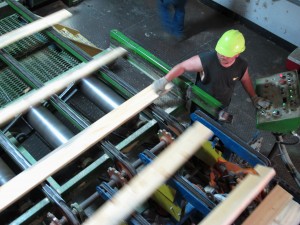Was A Small Idaho Sawmill A Smart Way To Spend Stimulus Dollars?

Molly Messick / StateImpact Idaho
A worker manned a machine as lumber headed to the stacker at the Emerald Forest Products mill this month.
It’s a rare thing for a small sawmill to try to get up and running while a crucial market driver for lumber — housing construction — remains in a national slump. So when the Emerald Forest Products mill reopened in Emmett, Idaho, this month, something unusual was happening. “That’s a news story,” timber industry expert Todd Morgan said of the new mill. “That’s like, ‘man bites dog’ instead of ‘dog bites man.’ It’s very counter to the trend to have a new mill opening during these market conditions.”
New home starts peaked in 2005, when construction began on more than 2 million homes. By 2009, the number had fallen to 554,000, a low not seen in 40 years of record keeping. Housing starts haven’t improved much since. Moreover, the housing crash came on the heels of decades of timber industry consolidation. Since 1990, Pacific Northwest mill closures have put thousands of people out of work.
Given all of that, how is the Emerald Forest Product mill making a go of it? Part of the answer is federal economic stimulus funding. To get up and running, the mill received $4 million in stimulus money through the U.S. Department of Agriculture. Mill owner Dick Vinson and his partners put up an additional $11 million, Vinson says.
The Emerald Forest Products mill has something of a troubled history, as StateImpact reported last week. Vinson first tried to get it off the ground in 2010, but the project foundered. Soon after that, Vinson and his partners filed for bankruptcy protection. In light of the market realities and the shaky path Emerald Forest Products has charted so far, it’s worth asking: Was a small-town sawmill a good bet for taxpayer dollars?
In interviews with more than half a dozen people including local officials, a former congressman and a regional coordinator for the U.S. Forest Service, the unanimous (and surprising) answer was “yes.” The reasons have to do with everything from the complexities of forest management to the American Recovery and Reinvestment Act‘s mandate to put federal dollars toward shovel-ready projects that might create jobs.
“There certainly, in my mind, is a need for a sawmill in that area,” says Scott Bell, regional Woody Biomass Utilization Coordinator for the U.S. Forest Service. Of the nearly $28 billion in stimulus funding the U.S. Department of Agriculture received, $1.15 billion went to the Forest Service. Four million dollars of that money went to Emerald Forest Products. Bell submitted the project for consideration.
“It’s fitting a niche,” he says of the mill. “Otherwise, logs would have to be shipped a long way. It’s providing employment.”
Most of the timber land in Idaho is national forest land. When the Forest Service has to manage that forest land for the benefit of wildlife, say, or to reduce the risk of fires, having a sawmill nearby is a good thing. It allows the timber to be put to use. Otherwise, Bell says, there is basically one option. “We would end up having to take any material that could not be sold and burn it on-site, which costs money and carries risks,” he says.
Todd Morgan with the University of Montana’s Bureau of Business and Economic Research builds on that point. “The wisdom in the federal government putting some money into the wood products industry, particularly in a Western state, is that those states have so much national forest land in them,” he explains. “Given the struggles the existing industry has had through the years with responding when there were good markets, it does make some sense to help stabilize the wood products industry in the short term during this down-market period.”
Like former Idaho Congressman Walt Minnick, a one-term Democrat who spent decades as a timber industry executive, Morgan believes there’s a place for a small mill in Emmett. There are nearby cities where home building wasn’t crushed in the housing bust, Morgan reasons, pointing to the example of Salt Lake City. Moreover, the supply of timber from Canada is projected to decline, because the mountain pine beetle has ravaged forests there.
There’s also a good argument for the mill from the standpoint of job creation. In Gem County, where the Emerald Forest Products mill is located, unemployment is 11.2 percent. It’s even higher in counties nearby.
“We’re a timber town, and we saw it as a viable opportunity to get something going again in Emmett,” County Commissioner Sharon Church-Pratt says of the mill. She met Emerald Forest Products owner Dick Vinson in 2004, when he first began thinking about building a mill in Emmett. Years later, Church-Pratt supported the project as a candidate for stimulus funds. “I still think it was a good move,” she says. “I think he’s going to make it. I really do.”


